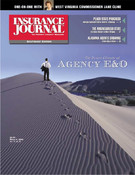According to the U.S. Census Bureau there were more than five million firms employing fewer than 20 people in 2001, not counting the millions of people who are self employed. Another 600,000 firms employed between 20 and 499 people and an estimated 17,000 employed more than 500.
According to the National Federation of Independent Businesses (NFIB), a typical small or independent business owner employs approximately five people and averages gross sales of $350,000 annually. NFIB’s members, however, “come in all sizes … farmers, manufacturers, service company owners, neighborhood retailers and wholesalers.”
Insurance is a primary concern of NFIB members and most small businesses, as disasters that larger companies can absorb may literally put them out of business.
With such a large market, it’s no surprise that almost every major carrier has some form of small business program. One of the best known is found at The Hartford, one of the top three carriers in the field. The Hartford defines small business as firms with up to 20 employees and/or up to $5 million in annual sales.
Symmetry and customization
“We basically offer two programs according to the size of the business,” said Hartford spokesperson Sue Honeyman. The company’s small business sector is called Select Customer and the product is Spectrum; its large small business sector is known as Select Xpand and the product is named Spectrum Xpand. “There’s a comforting symmetry in that, don’t you think?” Honeyman quipped.
Hartford’s Spectrum package begins with definitions. It separates businesses into more than 1,000 classes by type. Honeyman termed the breakdown as a way of achieving “mass” customization. “We found a way that allows agents to write more classes of business more quickly,” she continued. “They’re able to pinpoint insurance needs by industry without spending a lot of time, which makes underwriting easier and faster.”
Not only does it save time, it also lowers expenses. “But at the same time,” Honeyman said, “there’s sufficient complexity [in the system] to really evaluate the situation properly and assess and cover the risks.”
Technology makes it possible to acquire information quickly. No agent can spend an untoward amount of time on any one client, and being able to quickly evaluate a client’s needs and find the right carrier is crucial.
Carriers like The Hartford recognize this. “Agents are our primary sales force,” said Honeyman. “Everything we do is with the agent in mind. We are mutually dependent, and we want to make sure they do business with us and make a profit.”
With the right information available an agent can decide to talk to the Hartford or another carrier. “We can’t write every business,” said Honeyman, “but we can write most of them.” The other side being—if the risk is in a class the company doesn’t write, or in a location it doesn’t cover, the agent and the client know this and go to another carrier without wasting time.
Bigger sales, more employees
Conversely, once a working relationship is established with a carrier it tends to grow. This growth constantly changes the sector’s nature, so that a small business becomes something else as it grows.
The Hartford tried to recognize this trend recently with its new program aimed at “Big Small Businesses.” First, it noted that a number of today’s small businesses are rapidly expanding their operations, “moving into workspaces with higher property values, recording higher annual sales and hiring more employees.”
So, the Hartford upgraded its small commercial insurance offerings to embrace the needs of the “upper end of the small business market”—businesses with annual revenues or total property values of $5 million to $15 million.” Judy Blades, senior executive vice president of The Hartford’s property/casualty operations said the 600,000 small businesses within this segment represent an estimated $20 billion in annual premium. “We have retooled and enlarged our small business capacity and invested tremendous resources to provide the right product, service and technology to satisfy this important segment,” she said.
The company has set up a business unit, Select Customer Xpand, specifically to provide agents with “an easy and profitable means to write businesses that fall between the traditional small commercial and middle market segments.” The cornerstone product of the new business unit, Spectrum Xpand, is described as an “easy-to-write business owners policy (BOP) with enhanced coverages and customized limits for larger small business accounts.”
Specific features of Spectrum Xpand include:
• Broad underwriting appetite with more than 500 eligible classes across a variety of industries.
• Electronic vandalism and business income protection available for all business classes.
• Specialized Stretch endorsements—which bundle increases in individual base coverages and/or additional optional coverages in a single endorsement tailored to a specific industry group—available for broadcasters, building owners, business services, communications and media, special trade contractors, international, janitorial services, law offices, manufacturers, metal manufacturers, publishers, printers, retailers, technology and wholesalers.
Evolution of small firms
As The Hartford’s approach recognizes, it’s practically impossible to create a one-size-fits all type of coverage. Most businesses don’t remain static. As they grow, or they decline, new ones replace them.
Howard A. Smullen, executive vice president and chief operating officer of R.C. Knox & Co. of Hartford, Conn., summarized how small firms evolve at the Professional Liability Underwriting Society’s recent convention in Philadel-phia. “Entrepreneurs start small businesses with management centralized in the owner rather than professional managers. The board of directors is the family, there’s no CFO and no human resources director. Professional advice comes from outsiders, typically lawyers and accountants,” he told the PLUS meeting.
As the business grows the situation changes. “More outside management is needed and there’s more delegation of authority,” said Smullen. “Consequently policies [covering this type of business] become more complicated.”
Eventually the enlarged company, its owners and employees, face risks that were at best minimal when it was a smaller enterprise. Management now has to consider such issues as E&O for professionals, D&O, EPLI, increased workers’ compensation costs, health and other employee benefits, retirement plans and more. The needs keep growing.
“The U.S. economy now has around 1.1 million businesses with 20 to 1,000 employees,” said Jeff Jones, senior vice president and chief marketing officer of national broker U.S.I. Holdings. “It’s a big market sector, and no one broker has a dominant market share.”
U.S.I. offers programs for both smaller and larger businesses, but Jones believes the mid-market sector “has a desperate need for advice and for someone to ask.” U.S.I. has adopted a multi-faceted or cross-selling approach. “Their business needs are much greater than property/casualty insurance,” said Jones. “They need health plans, wealth management and other financial services, and the key we’ve found is to make these professional services available from a single source.”
In order to make its holistic model work even better, U.S.I.’s three year business plan calls for fully integrating service center personnel to address clients’ needs over the entire range of their business, making specialists in each area available to clients on a regular basis. “It’s not a question of going down the hall to ask advice, either,” said Jones. “These people are in each of our offices as part of the stewardship process. Each company’s needs are different—different products, different geographically—you have to find the right fit in order to become a strategic partner.”
The people handling these accounts may no longer be categorized as producers in the traditional sense, but as experts in the various needs required to properly manage the needs of mid-size businesses. “Part of our strategy involves bringing in new producers and assigning them to personal and small business lines for training and experience—to have them learn how these businesses work in the field,” Jones continued. “We’ve found that the carriers also want to participate. Eventually we are looking to create a small business specialist.”
Jones thinks this is all part of a necessary transformation of the agent into more of a financial advisor in the mid-size small business arena, where there’s explosive growth and clients are becoming more sophisticated. “Agents and brokers are going to need to provide a broad product line, which will see a separation between those who do and those who don’t,” said Jones. “Just because it’s a small P/C account, doesn’t mean it’s a small account.”
Topics Carriers USA Agencies Commercial Lines Business Insurance Property Casualty
Was this article valuable?
Here are more articles you may enjoy.


 Michigan Supreme Court Rules Against Couple in Drone Surveillance Case
Michigan Supreme Court Rules Against Couple in Drone Surveillance Case  Louisiana Governor Signs Package of Property Insurance Reform Bills
Louisiana Governor Signs Package of Property Insurance Reform Bills  The Top 15 U.S. Metros with High Exposure to Wildfire Risk
The Top 15 U.S. Metros with High Exposure to Wildfire Risk  Fannie and Freddie Hit Pause on Replacement-Value Requirements for Home Insurance
Fannie and Freddie Hit Pause on Replacement-Value Requirements for Home Insurance 


